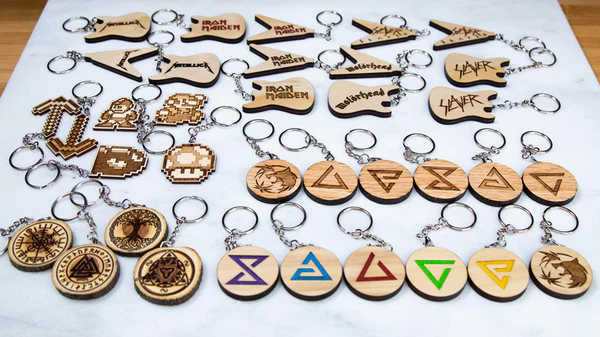DIYers and businesses that manufacture personalized items like keychains benefit from laser cutting technology’s features, such as precision and accuracy. Unsurprisingly, there is an upsurge in reliance on laser cutting and the need to answer questions like how to laser cut a keychain.
If you are a business or DIY looking for instructions on how to laser cut keychains, this article will break down the laser cutting process, keychains, and how to laser cut keychains to get a precise, professional, and quality finish.
What is Laser Cutting, and How Does It Work?
Before we discuss how to laser cut a keychain, you should understand the process and how it works to determine whether it is the right one for you.
Precision laser cutting is a highly recommended precision-cutting technique that uses laser technology to cut a material. It involves using a high-powered, computer-controlled laser, which heats and melts to cut a workpiece based on a design.
Due to its nature and the different types of lasers available, the laser cutting process is widely compatible with cutting keychains. Common materials are plastics like acrylic and polycarbonate, leather, stone, and metals like aluminum.
Materials and Laser Cutting Machines Suitable for Keychains
Your choice of materials for making a keychain will depend on the project requirements and will directly impact the keychain’s properties and even aesthetic appeals. Of the many laser-compatible materials available, plastics, wood, leather, and metals are the most common categories suitable for such purposes.
Plastics like acrylic and polycarbonate are cheap, easy-to-cut materials compatible with laser cutting. It also exhibits several functional and aesthetic properties, making it a top choice for keychains. Cutting a plastic keychain depends on the exact material, but generally, they are compatible with CO2 laser machines or sometimes UV lasers.
Wood’s rustic appeal makes it a top material choice for making keychains. Popular materials are birch plywood, cherry wood, and walnut. Like plastic materials, wood is compatible with CO2 and fiber lasers.
Leather offers a premium feel and is an elegant option for making keychains. Furthermore, laser cutting gives them a precise shape. Lastly, metals such as aluminum and stainless steel are the most commonly used to make keychains. They offer durability and longevity and can create a sleek, complex design with laser cutting.
Step-by-Step Process for Laser Cutting Keychains
The first thing to consider when cutting keychains is outsourcing to a laser cutting service or getting a laser cutting machine. Outsourcing to a service is the best option for enjoying a competitive price while avoiding the high cost of purchase and maintenance.
However, you can consider buying the machine if you need total control over its use, especially if you have the capital. The laser-cutting machine you choose will depend on the project and the type of materials you are working with.
After making a decision, the first step to laser-cutting a keychain is to design what you think the keychain should look like. You can use design software like Adobe Illustrator, CorelDRAW, or Inkscape to create your keychain pattern. Additionally, ensure the design is vector-based for a smooth laser-cutting process.
The next step is to choose the material you want to work with. Select the material that suits your needs and choose a laser cutting machine based on your design. For those outsourcing, the laser cutting service will expertly choose the laser cutting machine. Plastics have more color options, wood has a rustic feeling, leather has a premium feel, and metals are sleek and durable.
For those with laser cutting machines, set up the machine and import the design into the software. Adjust settings like power, speed, and focus, and fine-tune them by testing on a scrap of the same material. When fully satisfied, position the material on the laser cutter bed, secure it, and start cutting.
How Much Does it Cost to Laser Cut Keychains?
The cost of laser-cutting keychains depends on whether you are outsourcing or you have a laser-cutting machine you are using. Outsourcing the cutting process to a local laser cutting service could cost $0.2 to $3 per keychain, depending on the design, cost of materials, and even the service provider. For bulkier orders, there might be discounts. Furthermore, clients will not have to pay a high initial purchase and maintenance cost.
However, owning a laser cutter can have an initial purchase cost ranging from $200 for entry-level models to several thousand for professional-grade machines. A hobbyist laser cutter might be the most cost-effective option for small-scale production. In this case, the only costs to consider are the cost of materials and operation.
The material cost is peculiar to laser cutting and depends on the availability and value of the material. For example, plastics are cheaper than metals and will cost less. Other factors to consider include the complexity of the design.
Best Practices for Designing Laser-Cut Keychains
You can ensure high-quality keychains by considering the following during the laser-cutting process. First, opt for simple designs, as intricate details are challenging to cut, especially when working with small keychains.
Another thing to consider for a quality production is the spacing between design elements. You should have enough room between design elements to avoid weak spots or breakage. Additionally, the machine must be tested before real-time production to identify design flaws, materials issues, or machine issues.
Lastly, use layering for depth using different materials or colors for visual interest and multi-dimensional effect.
Conclusion
Are laser-cutting keychains worth it? It is a good manufacturing process for making customizable and professional-looking keychains. You can choose to DIY or outsource the task, but before then, understand the process, material options, and cost to get the best result, as outlined in this article.
With laser cutting, you can enjoy precision, flexibility, and a wide range of material choices, making it an ideal method for creating custom keychains that stand out for personal projects, gifts, or business branding.
